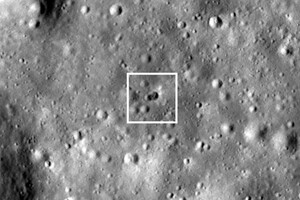Why a double crater formed on the Earth's satellite is not entirely clear.

NASA Lunar Reconnaissance Orbiter (LRO) discovered on the Moon, the crash site of a mysterious rocket that crashed into a satellite on March 4. Photographs taken on May 25 show a double crater formed by the collision, Science Alert reports.
It is noted that the double craters are unusual, but their formation is not impossible. Especially if the object fell at a small angle. But this does not seem to be the case.
Read also: The Chinese apparatus has found “double” evidence for the existence of water on the moon
According to astronomer Bill Gray, who discovered an unusual object and predicted its fall on the moon in January, the launch vehicle “came about 15 degrees from the vertical. So this is not an explanation for this object. ”
The crash site is an eastern crater 18 meters in diameter, which is superimposed on the western crater 16 meters in diameter. According to Mark Robinson, chief specialist of the LRO Camera team, such a crater could form an object with distinct large masses at each end.
“Usually, a spent rocket has a mass concentrated at the end of the engine; the rest of the rocket stage consists mainly of an empty fuel tank, “he said.
So what hit the moon? An unknown rocket attracted the attention of astronomers earlier this year. It was then thought to be the booster unit of the SpaceX launch vehicle, which launched the NASA Climate Observatory (DSCOVR) in 2015, bringing it to the Lagrange point of L1.
Gray, who developed space debris tracking software, noticed an object when his software showed an error. The program could not calculate the trajectory of the object after March 4, because then it had to crash into the moon.
Gray published his data and they quickly attracted the attention of scientists and the media around the world. But a few weeks later, he received an email from John Georgini of NASA's Jet Propulsion Laboratory. He noted that the DSCOVR trajectory should not have brought the launch vehicle to the moon. Trying to reconcile contradictory trajectories, Gray began digging into his data, where he found that back in 2015, he misidentified the DSCOVR launch vehicle.
That is, SpaceX was not involved. But there was another rocket, a fragment of which raced to the moon.
A small investigation conducted by Gray showed that it could be the booster unit of a Chinese rocket that took part in the mission “Chanye-5-T1 »In 2014. The astrophysicist Jonathan McDowell also provided evidence to support this theory.
It would seem that the secret has been revealed. But a few days later, China's interior minister said it was not a Chinese missile. According to Chinese authorities, the rocket fell into the ocean shortly after launch.
However, Gray believes that a fragment of a Chinese rocket crashed into the moon. According to the astronomer, the Chinese minister confused the launch vehicle of the Chanye-5-T1 mission with the launch vehicle of the Chanye-5, which really fell into the ocean.
As for the impact crater, it is so fast its discovery is amazing. The crash site was found only a few months after the incident. By comparison, it took more than six years of careful research to find the Apollo 16 S-IVB impact crater.




